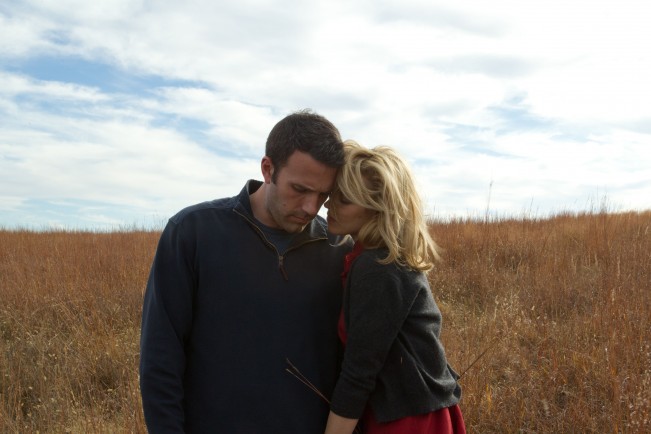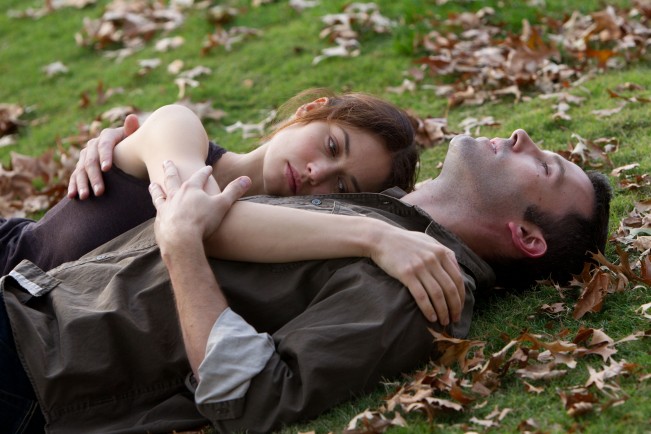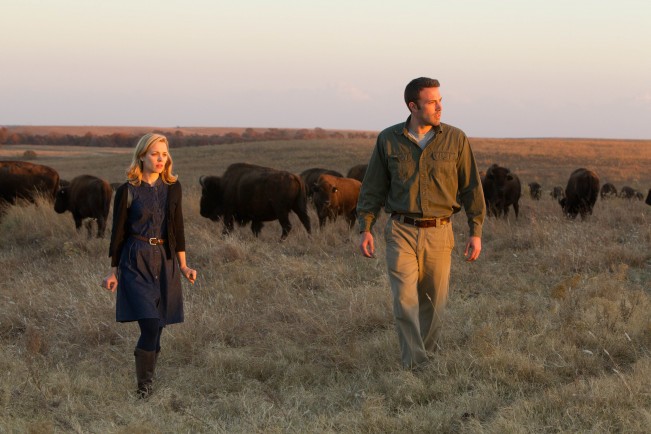

By Mike Wilmington Wilmington@moviecitynews.com
Wilmington on DVDs: To the Wonder
DVD PICK OF THE WEEK: NEW
TO THE WONDER (Three and a Half Stars)
U.S.: Terrence Malick, 2012 (Magnolia Home Entertainment)
I. Days of Heaven.
To the Wonder is one of those pictures that either knocks you out or irritates you—or maybe does a little of both. At its best, it’s a cinematic poem, another film of wonders by Terrence Malick, the writer-director of those American masterpieces Badlands and Days of Heaven. At its worst, it’s, well, it’s a little full of itself—the kind of movie some critics like to knock to prove they‘re not snobs, not obsessed auteurists, not in Malick‘s or anybody else‘s pocket.
It’s a love story—about an Oklahoma-born writer named Neil, played by Ben Affleck and somewhat based on Malick, and it’s about the two women he loves (Marina, played by Olga Kurylenko, and Jane, played by Rachel McAdams) both of whom are based on Malick’s wives, and about a melancholy priest named Father Quintana, played with sad, sad eyes by Javier Bardem, in his saint-rather-than-sinner mode—and probably borrowed from life as well.
All in all, it’s another strange, poetic, puzzling, stunningly visualized, and defiantly personal piece of spiritual autobiography on celluloid, an ambitious pictorially mesmerizing creation by an artist who makes movies as it the art form had just been invented, and he was free to do anything, try anything, but also by a man who’s hip to cinema technology and aware of other arts and literature as well—and finally, by a man who sees the world (in his films) with something like the newly opened eyes of a child (as a gorgeous, enrapturing place) and comprehends it with a child’s relatively fresh, unspoiled heart and soul. All of these seemingly contradictory artists are Malick, who, like Walt Whitman (another naïve and sophisticated poet) is large and contains multitudes and loves the way the sun pours down on leaves of grass.
That deliberately unabashed artistry (or, to detractors, artiness) is not all that unusual for Malick. Though he’s made only six feature films in his 40-year career—Badlands (1973), Days of Heaven (1978), The Thin Red Line (1998), The New World (2005), The Tree of Life (2011), and now To the Wonder (2012-3)—Malick‘s style and point of view, the kind of actors and performances he likes, even where he likes most to place and move the camera (staring from along the earth up at heaven)—are unique and almost unmistakable. The sets are dressed marvelously by Jack Fisk and the land lit glowingly by Emanuel Lubezki, and, under Malick’s guidance, it all has a look both intensely poetic and intensely human—as unique a visual style as Welles‘s, Murnau’s or John Ford‘s.
II. Badlands.
What is unusual though, especially coming only a year after Malick’s big critical hit and Cannes Film Festival Palme d’Or winner Tree of Life (also semi-autobiographical) is the sometimes vehement and even contemptuous critical drubbing he’s received from some reviewers, mostly serious ones, for this new film: the scornful dismissal of the film’s ravishing visuals as “perfume ad pictorials,“ the charges of narrative sloppiness and incoherence, and the reiteration of the indictment “pretentious.“ Roger Ebert liked it, praising it highly (and correctly) in the last wonderful movie review he ever wrote, but it’s the kind of movie that alienates a certain kind of critic.
Maybe it’s too personal. It’s an unusual film, as much classical as experimental. In a way, it’s a simple movie romance, about two people who fall in love in and with Paris (where movie couples often fall in love), and then marry and move to Oklahoma (where Malick also once lived) and where the marriage soon undergoes tumult and friction (as movie romances often do).
The original couple—Affleck’s Neil and Kurylenko’s Marina—have their Days of Heaven, and then their Badlands, especially when Neil’s old flame, McAdams’ Jane shows up and Bardem’s Father Quintana starts brooding in his (mercifully) almost empty church. Marina, a Ukrainian expatriate with a ten year-old daughter (Tatiana Chiline as Tatiana) has the same first name as Lee Harvey Oswald‘s Russian wife. But don‘t jump to conclusions. To the Wonder have socio-political content, but more of the Walt Whitman kind than Oliver Stone‘s:
The movie has a soundtrack made up of snatches of classics and semi-classics (Wagner, Berlioz, Haydn, Part) all merging into music of mutual and un-mutual attractions. Marina—trapped in Bartlesville, Oklahoma, after being brought down from the cathedral heights of Mont Saint-Michel in Normandy, France—is alienated and friendless. Quiet Neil is increasingly drawn to Jane, Jane to Neil and Father Quintana, sadly celibate, is drawn to Marina. And the camera is drawn to all of them—especially Marina, around whom it whirls like a drunken lover trying to encircle and capture forever his loved one’s special beauty.
III. Wonder.
To the Wonder, like other Malicks, has little dialogue and a lot of voiceover. Malick’s usual method is to write and film the dialogue scenes, and then cut them down (like documentary footage) in his protracted, sometimes years-long editing process. Days of Heaven was once three or four hours long, and there are, it’s said by Richard Corliss, three different, complete versions (linear, impressionistic and the final cut) of The Thin Red Line.
Wonder, Corliss says, was so heavily cut that the film lost whole characters, including five played by Jessica Chastain, Michael Sheen, Amanda Peet, Rachel Weisz and Barry Pepper. I second Corliss‘s suggestion that all five actors be restored for a supplement disc in the DVD release, preferably by Criterion, as Corliss also wants. If that sounds a pretty pretentious thing to want—well, so be it. I’d like to have seen the four-hour version of Easy Rider too. Not to mention von Stroheim’s Greed. Or Welles’ The Magnificent Ambersons. So what if Malick is his own Irving Thalberg or his own RKO? We don’t burn celluloid with a movie on it any more, at least not in plain sight.
What the critics who dislike Wonder seem to dislike most is that the movie’s characters are revealed less though dialogue and acting than through the flow of images—which are, as Roger Ebert noticed, like the flow in a silent film: by a Murnau, a Vidor, a Gance. Ebert also said that the actors in Malick’s film show the deliberately limited expressivity of the actors in a Robert Bresson film—and indeed Bardem at times suggests Claude Laydu, the country priest of Bresson’s Diary of a Country Priest. Silence… Narration. Music.
One can love something, a movie, a person, even if parts of it (or them) don’t work so well. That’s what I felt here. The sounds in To the Wonder—especially the voice-over and musical pieces that both Malick and Bresson use so well—are crucial to the film. But the story is powerfully told through the images as well: those visions of Hell, Earth and Heaven that convey a world of gorgeous nature and passionate people, caught by a Steadicam that keeps tracking and whirling around them. Move. Dance. Love. Tilt up: The sky. The wonder.


















Very nice piece of criticism.